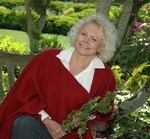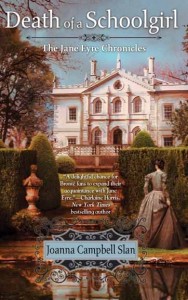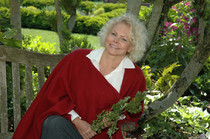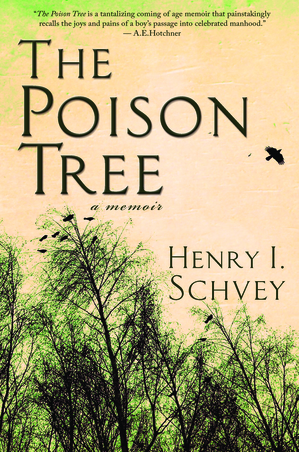Share the post "A Chat with Joanna Campbell Slan"
by Julie Earhart-Cracchiolo

Joanna Campbell Slan
I’m not sure exactly how I met Joanna Campbell Slan. I’m pretty sure that it was through the St. Louis Writer’s Guild, the Missouri Writer’s Guild, or author Susan McBride. Or maybe it was at the now-defunct The Big Read. It doesn’t matter; Joanna is a pleasure. A master scrap-booker, she has written several books on the subject. I don’t scrapbook, but when she started writing the Kiki Lowenstein Mystery Series (which are set in St. Louis), I became one of her biggest fans. To date, there are five Kiki books available (all excellent cozies) and eight short stories for those who have e-readers.
Joanna used to live in St. Louis but now she resides on Jupiter Island, Florida, where she writes overlooking beautiful beaches and blue water.
Her latest release is Death of a Schoolgirl: The Jane Eyre Chronicles. The first in a new series is a wonderful read. Since I don’t run into Joanna at Left Bank Books anymore, I thought Walrus Readers would enjoy hearing more about her:
Describe Death of a Schoolgirl for our readers.
Death of a Schoolgirl starts where Charlotte Brontë’s classic left off. Jane Eyre is happily  married to her beloved Edward Rochester, but their domestic tranquility is disturbed by news that his ward, Jane’s former student, Adéle, has been threatened. Problems with his vision preclude Edward from traveling, so Jane rushes to London to visit Adéle in a girls’ school. Upon Jane’s arrival, she’s mistaken for an errant German teacher. This mix-up gives Jane the idea to go undercover…but can she thwart a killer of young girls before it’s too late?
married to her beloved Edward Rochester, but their domestic tranquility is disturbed by news that his ward, Jane’s former student, Adéle, has been threatened. Problems with his vision preclude Edward from traveling, so Jane rushes to London to visit Adéle in a girls’ school. Upon Jane’s arrival, she’s mistaken for an errant German teacher. This mix-up gives Jane the idea to go undercover…but can she thwart a killer of young girls before it’s too late?
Where did you get the idea for Death of a Schoolgirl?
While on a Malice Domestic (mystery conference) panel, I was asked the name of my favorite mystery, and I said, “Jane Eyre.” Of course, a lot of people didn’t think of it as a mystery, but as I explained why I considered it such, the idea came to expand on the original book.
Death of a Schoolgirl takes up where Jane Eyre ends. Was that difficult?
No. There’s a “clue” given when Jane notes that Adéle, Edward Rochester’s ward, was sent to a girls’ school in London, but the situation did not work out. Those powerful words, “I wonder why…” set me thinking.
How many books do you think may be in the series?
I can foresee it going on and on. There’s so much happening in the 1820s that Jane has plenty to investigate.
Do readers have to be familiar with Jane Eyre to understand the story?
No, not at all. I do summarize what happened in the classic, and I believe Death of a Schoolgirl stands on its own merits as a story. It wouldn’t be fair to readers if they had to read the original first. That said, my fervent hope is that this book will lead many to revisit Charlotte Brontë’s masterpiece, and even to rediscover what a genius she was.
You’ve seemed to nail Jane’s voice. How did you do that?
I worked as a corporate speechwriter for a multi-national company, Diamond-Star Motors. Writing speeches for different nationalities—men from Cuba, Canada, Japan and the U.S.—taught me to listen for speech patterns.
Did you go to England to do research?
From 2001 to 2002, we lived in Sunningdale, Berkshire, six blocks from Agatha Christie’s home. During that year, I took advantage of every opportunity to travel around the U.K. that I could. We’re planning a trip this fall back to England, and then I’ll do more research.
Tell us about the research you did.
Visiting a carriage museum ranks as the most fun I’ve had in a long time. But beyond that, I read stacks and stacks of books. Usually at night after I finished writing. I also emailed an expert in British stamps. Strangely enough, some of the best research came from places you’d least expect it. For example, Sally Bedell Smith’s book Elizabeth the Queen told me a lot about the monarchy, useful stuff that hasn’t changed over the years.
How long did it take you to write Death of a Schoolgirl?
The idea came to me about five years ago. I spent a year writing a first draft, and six weeks doing an extensive revision.
We haven’t seen the last of Kiki Lowenstein, have we?
I hope not! I finished Kiki #6 yesterday. Next week I start writing new Kiki short stories and turning “old” short stories into an anthology.
Do you ever plan to create a book of Kiki’s short stories?
If you mean a traditional, paper book—yes. Coming soon.
What has been the biggest influence on your writing?
I can’t say that there’s been any single influence. Possibly getting my degree in journalism because it gave me confidence and discipline.
What was your favorite subject in school? Why?
History. I grew up in a family with deep historical roots. My ancestors signed the Declaration of Independence and loaned George Washington a half a million dollars to finance the Revolutionary War. We can trace our heritage back to Robert the Bruce.
Was Jane Eyre your childhood hero? Why? Of if not, who was?
Jane and Francie in A Tree Grows in Brooklyn were my two guiding lights. Both girls overcame tremendous odds, troubled beginnings.
What books did you enjoy as a child?
Oh, gosh. I read everything I could get my hands on. Mary Poppins (the original), Mrs. Pigglewiggle, The Borrowers, Charlotte’s Web, Classics Illustrated comic books, and anything that I found in my parents’ bookshelves. I would check out books from the public library, read them as I walked home, and have them finished by the time I went to bed!
What do you like to read now?
I am incredibly eclectic. Usually I have three or four books going at once. I’ve been reading a lot of history, as you can imagine. Right now, I’m reading The Brontës: Wild Genius on the Moors, an updated version by Juliet Barker.
Who is your favorite author? Why?
Charlotte Brontë—because she wrote my prequel!
What one thing would you like to do?
Write until I drop dead. I mean it. I have no desire to quit, and I love my life. I am very happy with every aspect of it.
A lot of writers read Walrus’ website, tell us about your writing habits.
I get up, get dressed and start work. The work-in-progress comes first. ALWAYS. Because if it doesn’t, you’re just fooling yourself.
I write every day. Some days I write as much as twelve hours at a stretch. I’ve worn the letters off of three keyboards.
I constantly try to improve my writing. I do my edits in passes (learned that from Todd Stone of Novelists Boot Camp fame). During each edit I try to tighten up my prose, cutting superfluous words, redundant explanations, and general meandering. Also, I look for weak verbs and change them to strong ones.
Recently I’ve started sharing my work with Beta Readers. That’s been incredibly helpful because they love my characters, and are invested in them, so they tell me their feelings about the work. My editors can spot errors, but only my fans can share their emotional reactions.
What advice would you give to writer’s who haven’t found an agent or a publisher yet?
The best way to find an agent or publisher is to attend a writers’ conference where you can pitch them.
What’s the best marketing advice you’ve ever received?
We were sitting by each other at Mystery Lovers Book Festival when Wendy Corsi Staub told me to write a lot of books. She was right. Today’s market favors the prolific writer. The more you write, the more often you have a reason to blog, to promote, and to visit booksellers. And your readers are more likely to stick with you because there isn’t such a gap between your books.
To learn more about Joanna, visit her at www.JoannaSlan.com




